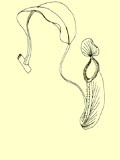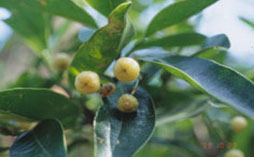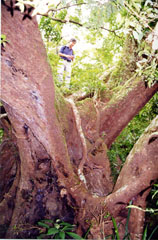

 |
![]() Acronychia
pedunculata
: the solution to a sweet mystery
Acronychia
pedunculata
: the solution to a sweet mystery
by Richard T. Corlett
![]() Ficus
concinna ( Miq.) Miq., a new Ficus found in Hong Kong
Ficus
concinna ( Miq.) Miq., a new Ficus found in Hong Kong
by Patrick Lai
by Richard T. Corlett and Ng Sai-chit
by Richard T. Corlett
Acronychia pedunculata : the solution to a sweet mystery
by Richard T. Corlett
Acronychia fruits are pale-coloured and the flesh has a crisp texture. As with the dominance of sucrose, neither of these characteristics is common in bird fruits, which tend to be black or red, with a soft pulp that is easily ingested by toothless birds. All our bird feeding records for Acronychia are of bulbuls (which have a sucrase) and all come from late in the winter when few alternative fruits are available. Most of the time, even bulbuls ignore them. This suggests that Acronychia fruits may be targeted at mammals rather than birds. A few seeds have been found in the scats of civets, which eat several other sucrose-dominated fruits, but not enough to suggest they are the major dispersal agents. The only other possibility in Hong Kong is fruit bats. Captive Cynopterus brachyotis – closely related to the commonest of Hong Kong's two fruit bats, C. sphinx – prefer sucrose to glucose and fructose in choice tests, and can also detect sucrose at lower concentrations than the other sugars (Herrera et al. 2000). The pale colour of Acronychia fruits, their texture, and their display on the outside of the tree crown are also consistent with dispersal by bats.
Although I have still not actually seen a bat taking a fruit, careful searches in the area around fruiting trees over the last 6 weeks have almost always revealed many roughly cleaned seeds concentrated under one or more trees within 20 metres of the Acronychia tree. These trees always have branches at approximately the same height as the Acronychia fruits and there is a clear flight path between the two trees. This matches the typical feeding behaviour of fruit bats, which select one or more ripe fruits and fly with them to a nearby 'feeding roost', where they are processed while the bat hangs upside down (Corlett 1998). Only the smallest seeds are swallowed, while those larger than 2-4 mm are dropped. Acronychia seeds are around 7 mm in diameter so they are always dropped. The bat then shuttles between the fruiting tree and the feeding roost with additional fruits while the seeds pile up on the ground below.
These observations do not just clear up a natural history mystery. This is also the first evidence that fruit bats are involved in the dispersal of a common forest tree in Hong Kong. Previous records of seed dispersal by bats in Hong Kong mostly involve figs (notably Ficis fistulosa, F. hispida and F. variegata, which seem to be dispersed entirely by fruit bats), and which are not important components of local forests.
Bibliography
Corlett, R.T. (1998) Frugivory and seed dispersal by vertebrates in the Oriental (Indomalayan) Region. Biological Reviews 73: 413-448.
Herrera, L.G., Leblanc, D. & Nassar, J. (2000) Sugar discrimination and gustatory thresholds in captive-born frugivorous Old World Bats. Mammalia 64(2):135-143.
Ko, I.W.P., Corlett, R.T. and R.J. Xu (1998) Sugar composition of wild fruits in Hong Kong, China. Journal of Tropical Ecology 14:381-387.
|
P.13-14 |
![]()
Ficus concinna ( Miq.) Miq., a new Ficus found in Hong Kong
by Patrick Lai
Hong Kong Herbarium, AFCD
|
P.13 |
![]()
The Flora of Tung Lung Chau
by Richard T. Corlett and Ng Sai-chit
The 2.5 square kilometer island of Tung Lung Chau lies just off the southern tip of the Clearwater Bay peninsula and due east of Hong Kong Island. It is one of several islands currently being considered as a possible future Country Park. At present, the Qing Dynasty fort in the north-east of the island is a Special Area but the rest of the island is unprotected. It is easily accessible at weekends by kaito from Lei Yue Mun and is popular with campers, as well as rock climbers, who make use of the spectacular cliffs along the east coast of the island. The view from these cliffs towards the Ninepin Islands is among the most wild and beautiful in Hong Kong.
Country Park status for Tung Lung Chau can easily be justified on recreational grounds, but there is very little biodiversity information available. To remedy this deficit for vascular plants, Ng Sai-chit, Wong Yim Wah, Laura Wong and Richard Corlett visited Tung Lung Chau on May 20th, 2000, and again, with the addition of Alvin Tang, on November 11th. On both trips, we listed everything we knew and collected everything we did not know, trying to visit all major habitat types on the islands. In total we recorded 348 species – an amazing number for such a tiny, rocky island! This is 16% of Hong Kong's total recorded flora of 2135 vascular plant species in only 0.2% of the total land area. This list is certainly incomplete and we intend to make further visits in the future.
The most interesting species so far is Marsdenia lachnostoma, for which this is the only recent Hong Kong locality. Other rare species included Cleyera japonica, Elaeagnus tutcheri, Litsea greenmaniana, Tutcheria microcarpa, Vitis bryonifolia and the fern, Notholaena hirsuta. Equally interesting was the list of species we did not find, which included Acronychia pedunculata, Cinnamomum parthenoxylon, Diospyros morrisiana, Elaeocarpus chinensis, Prunus phaeosticta and Tridax procumbens. All these species are - we thought - ubiquitous in Hong Kong, and they can all be found on the east coast of Hong Kong Island, less than three kilometres away.
|
P.14 |
![]()
The silence of the Acacias
by Richard T. Corlett
While walking in Country Parks over the last couple of months, I have several times been struck by a total absence of bird song when going past or through stands of Acacia confusa. The only exceptions have been when flocks of Japanese White-eyes pass through. Indeed, these flocks sometimes appear of follow rows of Acacia across otherwise treeless landscapes. Other bird-watchers have confirmed my impression that Acacia stands are particularly poor bird habitat. But, why? Kwok Hon Kai has shown that plantations of Lophostemon confertus have a much lower bird density than native secondary forests of similar stature (Kwok & Corlett, 2000), but bird diversity in these plantations is similar and, to the human observer, the lower bird density is compensated by greater visibility. Like most of our common plantation trees, Acacia confusa is not native in Hong Kong, but it grows naturally in Taiwan, so it might reasonably be argued that it is "less unnatural" here than Lophostemon, Eucalyptus or the American pines. Acacia fruits are dry but the "leaves" do show signs of herbivore damage, so it must provide at least some food for insectivores. The most likely explanations I can think of for the relative unattractiveness of Acacia stands, are the absence of the native understorey which provides fruits and insects in plantations of other exotic species, and the unique (for Hong Kong trees) substitution of leaves by "phyllodes" (flattened petioles), which may not provide a suitable foraging surface for birds larger than white-eyes.
Bibliography
Kwok, H.K. and R.T. Corlett (2000) The bird communities of a natural secondary forest and a Lophostemon confertus plantation in Hong Kong, South China. Forest Ecology and Management 130: 227-234.
|
P.13 |
|
Porcupine! |
 Copyright © 2000 |

